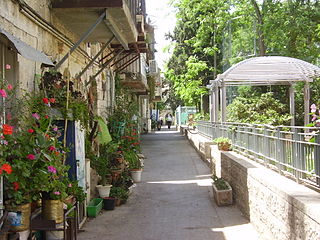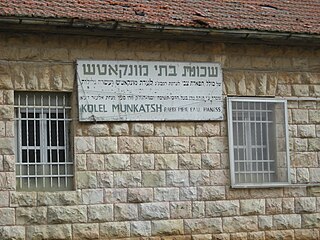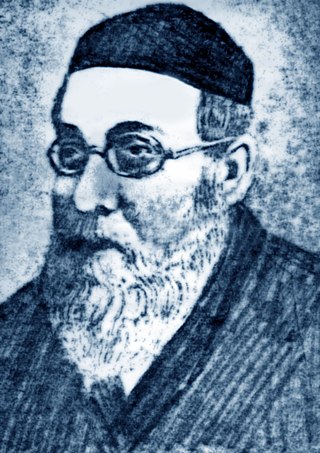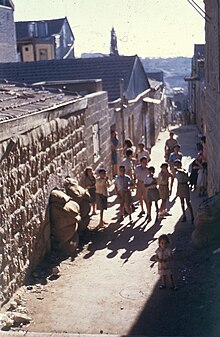
Geula is a neighborhood in the center of Jerusalem, populated mainly by Haredi Jews. Geula is bordered by Zikhron Moshe and Mekor Baruch on the west, the Bukharim neighborhood on the north, Mea Shearim on the east and the Jerusalem city center on the south.

This article deals in more detail with some of the notable synagogues of Jerusalem that do not have their own page as yet.

Mazkeret Moshe is a former courtyard neighborhood in Jerusalem. Today it is part of the Nachlaot neighborhood.
Avraham Wolfensohn (1783–1855) was a Jewish rabbi, Talmudic judge and leader of the Ashkenazi community in Safed, Ottoman Galilee in the mid-19th century.

The expansion of Jerusalem outside of the Old City walls, which included shifting the city center to the new neighborhoods, started in the mid-19th century and by the early 20th century had entirely transformed the city. Prior to the 19th century, the main built up areas outside the walls were the complex around King David's Tomb on the southern Mount Zion, and the village of Silwan.

Amram Aburbeh, also spelled Abourabia and Aburabia, was the Chief Rabbi of the Sephardic congregation in Petah Tikva, Israel and author of Netivei Am, a collection of responsa, sermons, and Torah teachings.

The Or Zaruaa Synagogue is an Orthodox Jewish congregation and synagogue, located at 3 Shmuel Refaeli Street, in the Nachlaot Ahim neighbourhood of Jerusalem, Israel. The congregation was founded in 1926 by Rabbi Amram Aburbeh for Maghrebi Jews from North Africa.

Batei Saidoff is a former courtyard neighborhood in western Jerusalem. Erected by Yitzhak Saidoff, a wealthy Bukharan Jew, in 1911, it was one of a series of courtyard neighborhoods built along Jaffa Road in the late 19th and early 20th centuries, together with Sha'arei Yerushalayim and Ohel Shlomo. In the 2000s the two buildings facing Jaffa Road were evacuated of tenants and redeveloped as upscale shops, and a 23-story luxury residential tower was constructed south of the courtyard.

Sha'arei Yerushalayim is a former courtyard neighborhood in western Jerusalem. It is one of a series of courtyard neighborhoods built along Jaffa Road in the late 19th and early 20th centuries, together with Ohel Shlomo and Batei Saidoff. Today it is considered part of the Mekor Baruch neighborhood.

Ohel Shlomo is a historical courtyard neighborhood in western Jerusalem. It is one of a series of courtyard neighborhoods built along Jaffa Road in the late 19th and early 20th centuries, together with Sha'arei Yerushalayim and Batei Saidoff. Today it is considered part of the Mekor Baruch neighborhood.

Batei Munkacs, also spelled Batei Munkatch, officially Batei Munkacs Tiferes Zvi, is a former courtyard neighborhood in Jerusalem. Established in 1928 by the Munkacser Rebbe, Rabbi Chaim Elazar Spira, Batei Munkacs is now part of the Nachlaot neighborhood.

David ben Shimon also known as Tzuf Devash and the Radvash was a rabbi who headed the North African Jewish community of Jerusalem in the Old Yishuv. Ben Shimon established Mahane Israel, one of the early neighborhoods outside the Old City walls.

Yitzchak Yaakov Yellin was one of the pioneers of the Hebrew language and press in Mandatory Palestine and then Israel. He was one of the founders and editor of the daily newspaper "Moriah", as well as the editor of the weekly newspapers "Lefi Sha'a", "Be'inyaney Dyuma", and "Hed ha'am". Yellin published Hebrew grammar books and was known as an educational figure who widely contributed towards the spread and use of the Hebrew language in Jerusalem of the early 20th century. He was also one of the founders of the Kiryat Moshe neighborhood in West Jerusalem.

Knesset Yisrael, also known as Knesset, is the name of a group of three former courtyard neighborhoods in central Jerusalem. Known as Knesset Aleph, Knesset Bet, and Knesset Gimmel, the housing project was planned by the Vaad HaKlali Knesset Yisrael and funded by overseas Jewish donors. The houses were completed in stages from 1892 to 1926. Beneficiaries of the housing were poor Haredi Ashkenazi families and Torah scholars connected to the Central Committee kolel system. Today Knesset Yisrael is part of the Nachlaot neighborhood.

Even Yisrael is a former courtyard neighborhood in Jerusalem. Built in 1875, it was the sixth Jewish neighborhood to be established outside the Old City walls. It is now part of the Nachlaot neighborhood. In 2004 the neighborhood underwent preservation and renovation by the Jerusalem Municipality, which re-paved and re-landscaped the central courtyard and added a small stone amphitheater for tour groups and daytime passersby.

Zikhron Tuvya, also spelled Zichron Tuvia, is a former courtyard neighborhood in Jerusalem. Founded in 1890, it was the twenty-third Jewish neighborhood to be established outside the Old City walls. The neighborhood consisted of parallel row-houses facing each other across a wide street, today named Zikhron Tuvya Street. Initially populated by tradesmen and workshops, it became a residential neighborhood after the 1920s. It is now part of the larger Nachlaot neighborhood.

Yosef Yitzhak "Yoshya" Rivlin was an Orthodox Jewish scholar, writer, and community leader in the Old Yishuv of Jerusalem. Scion of a family of Perushim, disciples of the Vilna Gaon who immigrated to Israel in the early 19th century, Rivlin spearheaded the establishment of the first Jewish neighborhoods outside the Old City walls. He helped found a total of 13 neighborhoods, beginning with Nahalat Shiv'a and Mea Shearim. His activities earned him the nickname Shtetlmacher ("Town-Maker"). He directed the Central Committee of Knesseth Israel, the supreme council of the Ashkenazi community in the Old Yishuv, for over 30 years.

Mahane Yehuda is a historic neighborhood in Jerusalem. Established on the north side of Jaffa Road in 1887, it was planned and managed by the consortium of Swiss-Christian banker Johannes Frutiger and his Jewish partners, Joseph Navon and Shalom Konstrum. By the end of the 19th century, it encompassed 162 homes. Originally occupied by upper middle-class residents, it became a working-class neighborhood beginning in the late 1920s. Today the neighborhood is part of Nachlaot. The Mahane Yehuda Market located across the street was named after the neighborhood.

Mashiach Borochoff House is a historical building located at 64 Jaffa Road in Jerusalem. Built in 1908 in eclectic style, its entrance is covered by an arcade with pointed arches supported by pseudo-Corinthian columns. The gate, in the style of 17th-century Georgian architecture, consists of two pillars connected by ironwork. A lion statue is placed atop each pillar. The house was built by Mashiach Borochoff, a wealthy Bukharan Jewish merchant, as a family residence. In 1947, a year after Borochoff's death, the property was sold to Barclays bank. It has functioned as a bank branch since that time.
Givat Moshe, also known as Gush Shemonim, is a Haredi Jewish neighborhood in Jerusalem bordering on Sanhedria, Mahanayim, Ezrat Torah, Shikun Chabad, and Tel Arza.

























